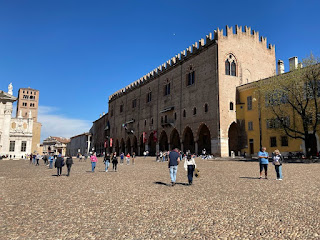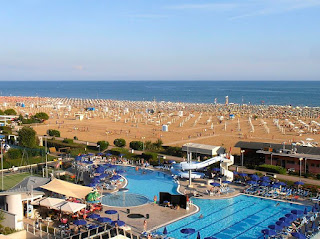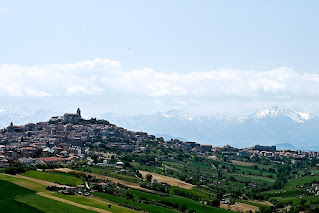Maestro’s Baroque music is still played today by enthusiasts
 |
| Giovanni Legrenzi came from a musical family in Clusone, near Bergamo |
Legrenzi was to become one of the most prominent composers of opera, vocal, and instrumental music working in Venice in the late 17th century.
His father, Giovanni Maria Legrenzi, had been a professional violinist and composer. One of his brothers, Marco, was also a talented musician. The brothers are believed to have been taught music at home and they became used to performing in their local church.
Giovanni Legrenzi became organist at the Basilica of Santa Maria Maggiore in Bergamo and was ordained as a priest in 1651. He became resident chaplain at the church, but continued to be involved in music and was given the title of first organist in 1653. The music he composed for Mass and Vespers was published in 1654.
Legrenzi is believed to have been involved in a gambling scandal and his appointment as organist was not reconfirmed the following year, but the offence was not considered to be serious and he had been reinstated by February 1655.
However, towards the end of that year, Legrenzi had resigned from his position in Bergamo and in 1656 he became maestro di cappella at the Academy of the Holy Spirit in Ferrara.
 |
| The Ospedaletto, where Legrenzi worked during his time in Venice |
Legrenzi’s position at the Academy gave him time to compose his own music and by the early 1660s he had published eight volumes of his work and had broken into the world of opera.
He ended his association with the Academy and supported himself with the proceeds of his published music and with his income from the land he owned in his native Clusone.
By 1670, he had settled in Venice, where he took up a position as a music teacher at Santa Maria dei Derelitti, more commonly known as the Ospedaletto, where he received commissions to compose oratorios.
He was a finalist for the appointment of maestro di cappella the Basilica of San Marco in 1676, losing by one vote, but later in the year he became maestro di coro at the Ospedale dei Mendicanti.
He became vice maestro at San Marco in 1682 and, by this time, he was one of the leading opera composers of his day. Among his students were Francesco Gasparini and Tomaso Albinoni.
Legrenzi finally became maestro di cappella at San Marco in 1685 but by this time his health was beginning to fail. He died in 1690, probably due to kidney stones, which caused him a lot of pain in his last few months.
His great nephew inherited his music and his books and produced four publications of Legrenzi’s work posthumously. Some of the composer’s unpublished work still survives in manuscript form.
Legrenzi composed 19 operas between 1662 and 1685, which were very popular in their day, but only a few have survived. Early music groups still perform his instrumental music and some of his surviving operas are performed at festivals.
 |
| The frescoed exterior of the Torre dell'orologio is one of the attractions of Clusone |
Clusone, a town in Val Seriana, just outside Bergamo, where Legrenzi was born, has been chosen as one of I borghi piu belli d’Italia - the most beautiful villages in Italy. It was founded around 1300 BC. Situated about 35km (22 miles) northeast of Bergamo, it nestles on a plain against the backdrop of the Alpi Orobie - the Orobic Alps - which is an area that attracts visitors all year round. Apart from its proximity to ski resorts, Clusone is famous for the frescoes that decorate some of its most significant buildings, such as the Municipio (Town Hall), the Torre dell'orologio (Clock Tower) and the Oratorio dei Disciplini (Oratory of the Disciplines), which has a macabre offering entitled The Triumph of Death. Clusone also hosts a prestigious annual jazz festival.
 |
| The Basilica of Santa Maria Maggiore in Bergamo |
The Basilica di Santa Maria Maggiore in Piazza Duomo in Bergamo, where Legrenzi served as organist, dates back to the 12th century. It is one of the most prestigious buildings in Lombardy and has a richly decorated cupola from the 16th century and some fine Flemish and Florentine tapestries and works of art. At the back of the church is an elaborate white marble monument designed by Vincenzo Vela, marking the tomb of opera composer Gaetano Donizetti, who was born in Bergamo and returned to die in his native city. Nearby there is a monument to his teacher Simon Mayr, who was once maestro di cappella in the basilica. There is also an elaborately carved wooden confessional designed by Andrea Fantoni in 1704 and an altar rail with wood carvings following designs by the Renaissance artist Lorenzo Lotto.
Also on this day:
1612: The death of composer Giovanni Gabrieli
1861: The death of anarchist Luigi Galleani
1901: The death of politician Francesco Crispi
1943: The death of mountain photographer Vittorio Sella
1990: The birth of footballer Mario Balotelli

.jpg)

.jpg)

.png)






.jpg)









.jpg)



.jpg)






